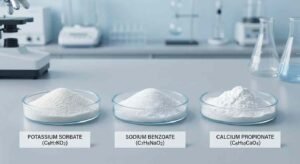
How Do Sample Orders Support Potassium Sorbate Purchasing Decisions?
Thinking of buying from a
Xanthan gum is a versatile and widely used food additive that has gained popularity in various industries due to its unique properties. It serves as a thickening, stabilizing, and emulsifying agent in numerous food and non-food products. This article provides a detailed exploration of xanthan gum, including its uses, functions, and safety profile, offering a comprehensive understanding of its role in modern food production and other applications.

Xanthan gum is a polysaccharide derived from the fermentation of sugars by the bacterium *Xanthomonas campestris*. It is produced by fermenting simple sugars such as glucose, sucrose, or lactose, after which the resulting polysaccharide is precipitated, dried, and milled into a fine powder. This powder, when mixed with water, forms a thick, stable solution with high viscosity, making it an essential ingredient in various products.
Xanthan gum is extensively used in the food industry due to its ability to improve the texture, consistency, and stability of products. Key applications include:
– Sauces and Dressings: Xanthan gum acts as a thickening agent, preventing separation and ensuring a smooth texture.
– Gluten-Free Baking: It provides the necessary elasticity and viscosity in gluten-free dough, mimicking the texture that gluten provides in traditional baked goods.
– Dairy and Non-Dairy Products: Xanthan gum helps stabilize products like yogurt, ice cream, and plant-based milk alternatives, preventing the formation of ice crystals and ensuring a creamy texture.
– Beverages: It is used to stabilize beverages, preventing ingredients from settling and maintaining a uniform consistency throughout the product’s shelf life.
In the pharmaceutical and personal care industries, xanthan gum is used for its stabilizing and thickening properties:
– Topical Formulations: Xanthan gum is included in creams, lotions, and gels to enhance texture and stability, ensuring even distribution of active ingredients.
– Oral Medications: It is used as a suspending agent in liquid medications, helping maintain the consistency and stability of the formulation.
Beyond food and pharmaceuticals, xanthan gum finds applications in various industrial processes:
– Oil Drilling: Xanthan gum is used as a rheology modifier in drilling fluids, improving the viscosity and flow properties of the drilling mud.
– Cosmetics: It is a common ingredient in cosmetic products, providing a smooth, spreadable texture and helping stabilize emulsions.
Xanthan gum’s primary function is as a thickening agent. When added to liquids, it increases viscosity without significantly altering the other properties of the liquid, making it ideal for sauces, dressings, and other fluid products.
Xanthan gum stabilizes emulsions and suspensions, preventing ingredients from separating over time. This property is particularly valuable in products like salad dressings, where oil and water-based ingredients need to remain uniformly mixed.
Xanthan gum helps to blend ingredients that typically do not mix well, such as oil and water. By stabilizing emulsions, it ensures that the final product remains consistent in texture and appearance.
In gluten-free baking, xanthan gum mimics the properties of gluten, providing elasticity and structure to dough and batters, resulting in baked goods with a more traditional texture.
Xanthan gum is generally recognized as safe (GRAS) by the U.S. Food and Drug Administration (FDA) and is approved for use in foods and other products by various regulatory agencies, including the European Food Safety Authority (EFSA). It is considered safe for consumption in the amounts typically used in food products.
Xanthan gum is a soluble fiber, meaning it is not digested in the small intestine but is fermented by bacteria in the colon. While this can have beneficial effects, such as promoting healthy gut bacteria, excessive consumption of xanthan gum may lead to digestive discomfort, such as bloating or gas, in some individuals.
Allergic reactions to xanthan gum are rare but can occur, particularly in individuals with severe allergies to corn, soy, or wheat, as these are the common sources of the sugars used in the fermentation process. Consumers with such allergies should check product labels carefully.
Xanthan gum is suitable for most diets, including vegan, gluten-free, and low-carb diets. However, individuals on a low-FODMAP diet may need to moderate their intake, as xanthan gum can contribute to fermentable oligosaccharides, disaccharides, monosaccharides, and polyols (FODMAPs), which may cause digestive issues in sensitive individuals.

Thinking of buying from a

Your custom blend is a pr

Are you struggling to cho

Are your food products sp
Xanthan gum is a multifunctional ingredient that plays a crucial role in various industries, particularly food production. Its ability to thicken, stabilize, and emulsify makes it an invaluable tool for manufacturers aiming to improve product texture and consistency. While generally safe for consumption, individuals should be aware of potential digestive effects and consider any dietary restrictions. As the demand for gluten-free and specialty products continues to grow, xanthan gum’s importance in both food and non-food applications is likely to increase.
WhatsApp us
We will contact you within 1 working days